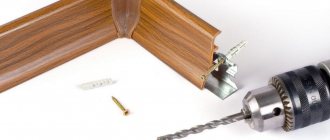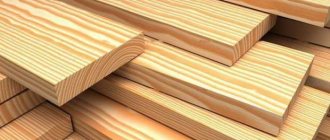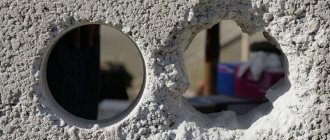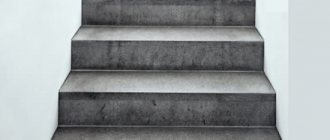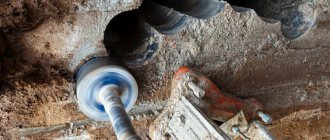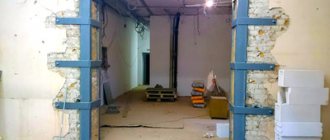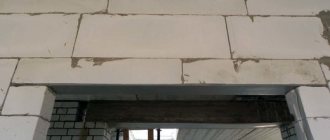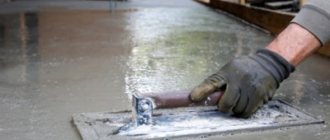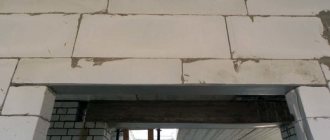Decorative panels are used to frame the flooring around the perimeter of the room. The plinth can be made of wood, plastic, or MDF. It would seem that it could be difficult to install it. But difficulties arise due to the fact that the apartments in block houses have concrete walls. As you know, the optimal mounting option should be selected for such a surface. Therefore, in order to perform the installation correctly, you should know how to attach skirting boards to a concrete wall.
Mounting methods
Depending on the material from which the skirting boards are made, as well as on the type of flooring, there are several ways to install these elements.
They differ from each other both in the method of fastening and in the fasteners used.
Using dowels
In this case, you need to screw the baseboard not to the floor covering, but to the wall. This is due to the fact that many materials used for flooring can expand and contract during use, so if a baseboard is attached to them, it will become deformed.
Most often, these elements are attached to a concrete or brick wall using dowels and screws:
- work begins from the far corner, a hole is made in the wall, a dowel is inserted into it, and then, using a self-tapping screw, the corner element is screwed on;
- First, the elements are attached to the long walls of the room; on level areas, the step between the fastenings should be 50-60 cm; if the walls are uneven, then additional screws are installed in the places of bends;
- also mounted on the opposite wall;
- if it is necessary to install an outer corner, then holes are made in it on both sides;
- existing joints are covered with decorative strips.
Instead of dowels and screws, you can nail the baseboard using nails that are fixed in wooden pins.
For clips
Often plastic skirting boards and strips made of other materials are attached to special fasteners, which allows, if necessary, to quickly and easily dismantle them.
The work is performed in the following sequence:
- in increments of 30-40 cm, special clips are securely attached to the wall; if the surface is uneven, then they are installed more often;
- The bar is inserted into the clips and with a light blow with your fist, it is securely fixed in it.
On glue
Can be installed using glue or liquid nails. This can be done in the case when you do not plan to dismantle these elements, since you will no longer be able to remove them without damage.
Installing skirting boards with glue is only possible if the surface of the walls is perfectly flat, otherwise the elements will not be able to adhere tightly to it.
Glue for baseboards “Instant Grip” or “liquid nails” is applied in drops to the plank in increments of 40-50 cm, after which the element is pressed tightly against the wall, held slightly and a strong fastening is obtained.
Thus, you can attach it directly to the wallpaper , then it will be easier to dismantle it. Using glue, you can install these elements on curved walls, but before that, a leveling strip is fixed to them.
Without splice application
We looked at installation with corner elements, but you can do without them.
First, the ends of the planks that are placed in the corner are cut off at an angle of 45 degrees using a miter box, after which they are mounted end-to-end, and the joints are covered with a decorative strip.
Installation of skirting boards with cable duct
In this case, fastenings can be done using one of the described methods, but before starting work, remove the strip covering the cable channel from the baseboard, install it, install the cable and close the strip.
Things to remember
There were no significant differences in the principles of fastening PVC systems to walls. In any case, the plinth must be installed without distortions. Only the materials used for installation differ (described above).
Plastic skirting boards are not attached to the floor. This is partly due to the design of the molding (a kind of “foolproofing”). Even if we assume the possibility of a non-standard placement of the strip, this is where it all ends - the fittings assume an exclusively wall location.
Some difficulties arise when going around radius walls with plastic skirting boards, but by alternating small sections of strip and connecting elements you can adequately get out of the most difficult situation.
There is an opinion about the advisability of using thermal blowers when working with PVC systems in difficult areas. However, we should not forget that identical temperature effects on plastic of different thicknesses can produce different results. And the thickness of the plinth planes varies over the entire width, only based on this, it is extremely difficult to predict the final result under the influence of high temperatures.
Mounting features
Depending on the material from which the plinth is made, one or more of the described methods for installing the specified elements is used.
Installation of plastic plinth
Such elements can be installed with glue, with special clips or with self-tapping screws. When installing with glue, there is no dust; before attaching the floor plastic plinth, you need to clearly measure them, keep in mind that they are glued once, and they cannot be dismantled.
It is necessary to dose the glue correctly and try not to smear the floor covering.
If you want to securely fasten, use self-tapping screws . Although this is a lengthy process, it is the most reliable.
First, holes are made in the plank at a distance of 50-60 cm, then it is placed against the wall and the places for the dowels are marked. In the marked places, holes are made into which dowels are inserted, after which a strip is applied and secured with self-tapping screws.
When screwing self-tapping screws into a plastic baseboard, you must ensure that it does not bend or crumple.
If the strips do not have a cable channel, then the caps of the screws are closed with special plugs, which the craftsmen recommend gluing, and if there is a cable channel, then they will be closed with a special strip.
Plastic plinth can be attached to the floor using special clips .
This installation method allows you to dismantle the baseboard, but when using it, the walls must be perfectly flat, and this is not always the case.
Do-it-yourself installation of plastic skirting boards, step-by-step instructions:
- Mounting points are marked on the wall;
- holes are made in the baseboard;
- insert dowels and, using self-tapping screws, attach special clips, the distance between which is 40-50 cm;
- Now all that remains is to apply the plinth and with the help of light blows with your fist, it is fixed.
Wooden
Installation of wooden plinths is more difficult than plastic ones, since there are no special corners. The corners are butted together and in order to cut the baseboard correctly, you will need a miter box. It's rare that a room has a 90-degree angle, so the adjustment of the planks is usually done locally, and done by hand.
If it is necessary to join wooden planks along the length, you need to make even cuts and select the material so that there are no knots or chips in this place.
Installation is carried out using self-tapping screws, with a distance between them of 70-100 mm. After marking, screw the screws into the plank so that they appear slightly on the other side, then place the plank against the wall and mark the holes for the dowels. Drill holes, insert dowels and fix the bar.
Installation on finishing nails is carried out using the same technology, but instead of plastic dowels, wooden pins are used. This method allows you to make the attachment points invisible, but it is not suitable for uneven and loose walls .
MDF skirting boards
Depending on whether you plan to remove the plinth after a while or not, you choose the method of its installation. MDF skirting boards are most often installed with glue , but in this case, the walls must be perfectly smooth.
You can fasten such elements using self-tapping screws or clips; the technology for performing the work is the same as in the previous versions.
If you do the installation incorrectly, you can damage both the plank itself and its fastening, so the work should be done carefully and slowly.
How to properly fasten skirting boards to a concrete wall: wooden, plastic, MDF
Decorative panels are used to frame the flooring around the perimeter of the room. The plinth can be made of wood, plastic, or MDF. It would seem that it could be difficult to install it. But difficulties arise due to the fact that the apartments in block houses have concrete walls. As you know, the optimal mounting option should be selected for such a surface. Therefore, in order to perform the installation correctly, you should know how to attach skirting boards to a concrete wall.
Expert advice
If you decide to install skirting boards yourself and want to do this work efficiently, you must adhere to the following expert advice:
- The plinth is installed only after the walls have been finished and the flooring has been laid.
- Count the number of internal and external corners, take into account the length of the room in order to purchase the required amount of fittings;
- The joining of skirting boards in the corners is carried out using special fittings, which are available for plastic elements.
- Wooden, MDF, ceramic and polyurethane elements are joined end-to-end, with their sides trimmed using a miter box.
- If the walls and corners are uneven, then you can first make strips of cardboard that match the size of the baseboard, put them in place and cut them to the shape of the corner. Using the prepared stencil, the planks are already trimmed.
- If it is necessary to attach the plinth to plasterboard , it is necessary to take into account that this material does not have high strength, so special fasteners are used, which are called “Butterfly” or “Molly”; installation can be done using glue .
Before purchasing these elements, you need to decide on their type and calculate the required amount of material.
Skirting board care
The difference between floor profiles lies in shape, size, and materials. On the building materials market you can often find wooden, veneered, plastic, metal, and rubber models. Their cleaning depends on the parameters of the product.
Oil or polyurethane paint is often used to paint wooden planks. To avoid damaging it, wipe the structure with a soft sponge using washing gel or universal spray. To prevent drips, spray the product not on the panel, but on a rag. Stubborn stains can be removed with the rough side of a sponge if it does not scratch the surface.
Metal panels are not susceptible to mechanical damage, but you should not use sandpaper or metal scrapers. The main purpose of caring for such a plinth is to eliminate dust and bring the structure to a shine.
Vinyl or rubber panels are systematically polished using special products. Otherwise, the baseboards will become dusty and dirty. You can remove dirt with a wax cleanser. After a few minutes, wipe the bar with a brush and a wet sponge.
Before washing the panels with a new product, you need to test it on a small area. It is better to start the procedure with soft liquids, systematically wiping off dirt with a wet cloth. It is necessary to begin thorough removal of dirt monthly. After using powerful chemicals, the baseboards should be wiped with a wet cloth - this will prevent the formation of drips and stains.
Using glue
Attaching the decorative strip to the concrete surface with glue is the easiest method you can use.
The ease and speed of the process sets glue fastening apart from other types. The material is fixed with “liquid nails” or connecting glue. To perform work on a smooth surface, without errors, a connecting mixture, hermetic composition, a ruler, and a spatula are sufficient. When the wall does not have a smooth surface, the walls will first need to be adjusted and the errors repaired.
The place where the plank is attached to the wall should be marked. It is difficult to control the force at which the glue is firmly held on the wall, so for convenience, the plank is cut into equal elements. The inside of the parts is filled with a paste-like hermetic mixture (glue), the layer of which is leveled with a spatula.
The decorative strip is brought to the concrete and pressed down firmly. How to ensure a tight fit of the baseboard? You can secure the ends of the panel with self-tapping screws, if the plinth is wooden - with studs, if this is not possible, press the material to the wall with heavy devices. This type of fastening has its disadvantages:
- It is not possible to reuse the plinth; it is attached only once;
- exceptionally smooth surface;
- Apply the glue carefully so as not to smear the surface.
Return to contents
Types of fillets
Fillet is the second name for a plinth, received for the presence of a groove on the outside of the part. Among the most common materials used in the production of fillets are:
- foam products;
- polyurethane products;
- wooden baseboards;
- PVC profiles.
Polyurethane
Polyurethane skirting boards differ from others due to:
- The density of the material, thanks to which polyurethane products are strong and durable.
- Beauty. Decorative elements on polyurethane are more clearly visible than on other materials.
- A large selection of colors and styles, significantly expanding the model range.
- Possibility of installing hidden suspension.
Foam
A material that, despite its low cost, has a decent set of positive characteristics:
- low weight of products;
- ease of installation.
Flaws:
- fragile;
- afraid of high temperatures;
- does not interact well with some types of glue.
PVC profile
Affordable and high-quality material, noted by both professional finishers and ordinary people. Pros:
- heat resistance;
- does not collapse under the influence of ultraviolet radiation;
- easy to process and install;
- not afraid of exposure to water.
Minuses:
- not suitable for installation on curved walls;
- When exposed to high temperatures for a long time, it begins to deform.
Wooden
This material is gradually falling out of use, being replaced by cheaper and more practical counterparts. Despite this, wood skirting boards have many advantages:
- service life is not inferior to most alternative materials;
- wood products are the most environmentally friendly;
- beauty;
- can be painted.
Flaws:
- difficult to install;
- are expensive;
- Wooden skirting boards require special care.
What should I attach the bar to?
First of all, you need to solve several organizational issues:
- If your floor is wooden, that is, traditionally plank or parquet, and the wall consists of concrete, then it is better to attach the baseboards to the horizontal plane.
- There is also the opposite rule: if the floor is concrete or screeded, and the walls are made of wood, it is better to attach the baseboards to the wall.
Important! Before attaching a plinth to a concrete wall, consider what the cladding is made of. If it was leveled with gypsum board, soft stone, or plaster, the baseboards will have to be secured using special yellow finishing nails (they have miniature heads). It is better not to use screws, dowels and nails, as they will not hold the plank securely.
- You can glue the plinth to a concrete wall using “liquid nails.” However, it is worth taking into account that it will be very difficult to remove the slats later.
- You can also secure the slats with special clips (or clamps). Please note that if you have not worked with such material before, then it is better not to take on the work.
Pre-installation work
Fastening the plinth will depend primarily on the quality of the wall. It will fit perfectly on a smooth and even wall without gaps. The installation itself will be quite simple. If the wall is uneven, it will be difficult to position the rail in the desired position, so the process itself will take a longer time. Before attaching the baseboard, it is important to prepare the walls. As a rule, their plane is leveled with a layer of plaster.
PVC slats are more flexible than other types of slats. It is easier to work with, and its position relative to the floor is much easier to select. Unfortunately, the PVC lath fits perfectly only on the surface without any changes.
If there are any, then large gaps between the floor and the plank will be visually visible. Before installation, it is important to select the correct fillet. It must be free of defects, cracks, scratches and chips. If there is a need to hide wires, then fillets with internal grooves are suitable.
You should purchase auxiliary parts from a hardware store: connectors, external corners and internal plugs. It is important that they match the fillets in color.
Purchase corners and caps immediately with baseboards
There are plastic fillets on sale that are designed specifically for carpet. The strip itself has a groove for covering, so the carpet should be covered after all construction work has been completed. This will prevent the coating from getting dirty and maintain the original appearance of the material.
PVC skirting boards harmonize perfectly with linoleum and self-leveling floors. Anyone can install a plastic skirting board on a wall. It does not need to be sawed down and adjusted to the desired size; it is joined with connectors.
Before purchasing plastic skirting boards, you should calculate the required number of slats. As a rule, the length of each is 3 m. During the installation process, unforeseen situations occur when the material breaks or is rejected, so you should purchase slats with a small margin.
Types of compositions used
In construction, during the renovation of residential premises and their final finishing, the following adhesives are used:
- liquid Nails;
- silicone sealants;
- docking;
- putty;
- polymer compositions;
- hot melt adhesive.
Liquid Nails
It is considered a universal glue used to work with:
- tree;
- metal;
- drywall;
- glass;
- Chipboard.
The substance reliably fixes the glued elements to each other, allowing you not to worry about the safety of the repair. The only drawback is considered to be poor compatibility with wet surfaces, which do not allow the composition to adhere securely.
Silicone sealants
Viscous adhesive compositions, among the main advantages of which are:
- fast hardening;
- seam elasticity;
- waterproof;
- long service life.
Does not perform very well when working with wet surfaces or materials containing plastic.
Docking
Special adhesive for working with skirting boards, which often contain polyurethane. It is much more effective than liquid nails. Used to fix ceiling plinths at joints and transitions. Pros of glue:
- quickly sets to the work surface;
- paint adheres well to it;
- has great adhesive ability.
Polymeric
A universal product with a large number of positive reviews from customers. Pros:
- strong adhesion to the surface being treated;
- dries quickly;
- economically used;
- easy to apply even to hard-to-reach areas.
putty
Putty is considered a worthy alternative to glue. Its use allows you to achieve:
- reliable, durable fixation of the baseboard;
- quick drying of the seam.
Flaws:
Working with putty is more difficult than working with glue and, in most cases, only experienced finishing workers work with it.
Hot melt adhesive
It is used in cases where large temperature changes are recorded in the room where the skirting boards are installed. Hot-melt adhesive is easy to apply, does not have an unpleasant, specific odor and hardens quickly.
Drywall dowels
Particular care must be taken when choosing and, accordingly, installing dowels for drywall. To secure a shelf or cabinet to drywall, you will need special dowels. Their choice will largely depend on the weight of the suspended structure. If you make incorrect calculations, there is a high risk that the structure will simply fall.
One of the most common types of dowels is the plug dowel. It consists of two parts, namely a cork and a dowel, respectively. In most cases, it is used for fastening certain objects in a concrete wall. Its spacer part consists of three nylon sections. There is a passage hole in the tail section. It is this that greatly facilitates screwing, as well as good movement of the screw during the process of tightening it. Thanks to the expansion, which is carried out simultaneously from three sides, the dowel is securely held in the wall. In some cases, the dowel plug can also be used for fastening in drywall. However, as experts recommend, it is better not to take risks. Although some people consider a dowel-plug to be a universal fastener, it is best to use a special dowel-nail. In general, all specialized dowels for drywall have one main difference - the harpoon expansion principle. It is he who ensures high-quality fastening of the structure. All drywall dowels can be divided into two groups:
Spring pass-through
Walk-through dowels are practical in cases where the fastening should be carried out in the ceiling, for example, when installing a chandelier. The spring pass-through dowel has a threaded metal rod, a spring mechanism, and folding locking wings. During its installation inside the plasterboard structure, the spring mechanism opens when acted upon by the locking hook-wing. This creates a reliable fastening. In this case, the other end of the spring dowel can have a different shape: in the form of a ring, a rod, a screw, etc. The choice of shape is directly influenced by the object that will be suspended. This mechanism is also practical in cases where the drywall is lined with ceramic tiles.
Self-tapping dowel
This type of drywall dowel is made from two different materials:
- Nylon grade TT22.
- Metal DRIVA.
As a rule, they are used in cases where it is necessary to attach to a single-layer or multi-layer plasterboard sheet. Moreover, it may have a decorative coating and insulation on the inside. The main difference between self-tapping dowels is their size. When choosing it, you should make sure that it will not stick out on the other side. As for the DRIVA self-tapping dowel, it is made from an alloy of aluminum and zinc. It is noteworthy that to attach them there is no need to pre-drill a hole in the drywall. The end of such a dowel is equipped with its own drill. They screw very easily into drywall, providing a secure fastening. They can withstand quite a lot of weight of an object. The dowel itself is tightened using a simple screwdriver or screwdriver.
Note!
If the sheet thickness exceeds 15 millimeters, then it is recommended to first drill a thin hole.
Dowel umbrella
Preparatory work
Before starting installation, you should pay attention to the following nuances:
1. The wall must be smooth and even - this will prevent the installation of the baseboard from being crooked with gaps.
2. The first stage is preparing the walls. They are first leveled with plaster, then sanded. It is recommended to use slats made of polyvinyl chloride; they are characterized by greater ductility, ease of installation, and convenient location to the floor. The disadvantage of such slats is the need for a perfectly flat surface without waves or transitions. Otherwise, cracks and gaps may form.
Skirting mounting diagram
3. An important step is the selection of fillets. It should not have chips, cracks, scratches or other defects. You can hide the wires if the fillet has internal grooves. It is also necessary to stock up on auxiliary parts such as connectors, external and internal corners, and plugs.
4. There is a large selection of fillets for carpeting on the building materials market. The strip itself has grooves for the carpet, so it can be laid after the final completion of the work. This will allow the material not to get dirty and lose its attractiveness and presentability.
5. Models made of polyvinyl chloride are well suited for linoleum and self-leveling floors. Thanks to butt connectors, anyone can attach a plinth to a concrete wall, since it does not need to be cut or adjusted to size.
Before starting work, you need to stock up on the required number of slats and tools. The installer will have to use the following tools:
- drill;
- a screwdriver with various attachments;
- grinder;
- with a hacksaw.
Be sure to have a tape measure, scissors, screwdriver, and construction knife on hand.
Organizational matters
First of all, you need to plan your actions.
What is the best way to attach the plinth?
Clamp for fastening slats.
- If the floors are wooden - traditional planks, parquet, made of solid or parquet boards, and the walls are concrete, it is better to fix the baseboard to them. Driving screws or nails into concrete walls will be much more difficult.
- The opposite rule also applies: if the floors are concrete or screeded, and the walls are wooden, fixing the baseboards to the wood is much easier.
Note! Before attaching the plinth to a concrete wall, consider what it is lined with. If it is leveled with gypsum board, plaster, or soft stone, then the skirting boards can only be secured with special finishing nails (yellow) with miniature heads. Ordinary screws, dowels and nails will not hold securely in such a base.
- It is also possible to attach plastic skirting boards to a concrete wall by gluing them to “liquid nails”. However, here it is worth considering that it will not be possible to remove the strips later.
- Another modern method is to fix the slats with special clips (clasps). However, if you do not have experience working with such fasteners, it is better not to take on the job.
Wood, plastic or MDF
Now the choice of baseboard material is quite extensive. You can choose natural wood, plastic or MDF:
- If the floors are assembled with your own hands from piece, panel parquet, solid, parquet, tongue-and-groove boards, then a wooden plinth will harmonize with them.
- When the floor covering is self-leveling floors, ceramic tiles, laminate, carpet, linoleum, it is best to use plastic or MDF baseboards.
The decorative profile can be fixed to a concrete wall in several ways:
- self-tapping screws with plastic dowels;
- gluing to surface;
- mounting fasteners.
Wooden plinths are attached to concrete with nails, and instead of dowels, inserts are used - plugs made of the same wood. Instead of nails, you can use a special tool - a miniature hairpin.
Fasteners
There are decorative panels with a special type of fastening - metal clips. This type of fastening is not included in the product package, so it must be purchased separately. The following algorithm is performed for installation:
- Places for fastening outlets are marked. The distance between the elements is set within 50 cm, it may be different - the specifics are reflected in the user instructions.
- Drilling holes. Plastic dowels are mounted in them, to which fasteners are attached with self-tapping screws.
- Installation of baseboards. This is done after “masking” the wires by simply snapping them into place. If the need arises, the decorative panel can be easily dismantled.
Fastening with glue
A method of installing skirting boards, which is distinguished by its ease and high installation speed. To do this, buy connecting glue - “liquid nails”. Places for installation are marked on the concrete surface of the supporting structure. Since it is difficult to manually apply force to securely fasten the decorative element, the plank is cut into 3 equal parts. The inner part is treated with glue, it is leveled with a spatula. Next, a fragment of the plinth is brought to the wall and pressed down. To secure the panel tightly, the ends of the decorative means are mounted to the surface with self-tapping screws or studs and pressed down with heavy objects.
Bonding procedure
Before starting work, it is important to choose a high-quality adhesive composition. It is liquid nails that are considered universal; in their absence, replacement with glue 88 is allowed. It can also glue most known materials, while being moisture resistant. Among liquid nails, you should choose such as “Tytan”, “Moment Montazh”, “Antia”, “Dragon”, “Crass”, “Master Klein” in cylinders. “ProfiMaster” has also proven itself well, sold in 1-3 kg jars.
In order to glue the baseboard to the floor and wall, you will need a number of tools:
- roulette;
- nozzle-gun for liquid nails in a cylinder;
- hacksaw;
- hammer;
- rubber spatula;
- knife.
To make the task of inserting fillets in corners easier, you can purchase a miter box, but this is not necessary. It can be replaced with a self-made template, according to which markings are applied. There are self-adhesive fillets, they are even easier to install and the process takes a minimum of time.
Is it possible to replace the baseboard without damaging the wallpaper? Yes, it is possible to attach it between the floor and the wall without harming the wall decoration. If you plan to re-glue the wallpaper in the near future, it is better to hold off on attaching the baseboard. Otherwise, you will have to tear it off, which can damage it irrevocably (this is especially true for wooden products).
What to choose: wood, plastic or MDF
Various materials are used for the manufacture of decorative strips, so the products differ not only in appearance, but also in the mounting option.
Skirting boards should be selected taking into account the surface of the walls and floors to which they are mounted:
- Wood planks can be used in dry rooms, with a base made of laminate or parquet tiles.
- Wood-fiber MDF skirting boards are stronger in strength than wood, and in appearance they are close to laminated ones.
- Plastic panels are considered universal - suitable for almost all floor coverings - linoleum, laminate, parquet, self-leveling and cork floors, tiles, porcelain stoneware. Plastic strips are resistant to moisture, so they can be used in the bathroom.
The design of the butterfly dowel and its installation
A butterfly dowel is a fastening device that resembles a butterfly in shape. During the process of twisting, the dowel is compressed, due to which special legs are pressed against the back wall of the drywall. One of the advantages of this fastener is that it increases the area of pressure generated when hanging an object. In other words, the specific shape of the butterfly dowel evenly distributes the entire resulting load on the drywall. Several design features should be highlighted:
- Used for installing single and double sheets of drywall, respectively. The butterfly dowel can also be used for fastening chipboard, gypsum fiber board and other sheet building materials that are suitable in thickness.
- Sold complete with a self-tapping screw according to the length and type of thread. However, if for some reason it does not fit, you can replace it with another type of screw.
- The part of the dowel that is inside the drywall sheet does not rotate around its axis. This is achieved thanks to the ribbed surface of the element.
- Internal threads on the far head facilitate clamping and folding. And the presence of special internal legs, which are attached to this head, provide greater rigidity when the butterfly dowel is twisted.
How can you fix a plastic floor plinth and what is needed for this?
Installation of floor plinths, in most cases, is not particularly difficult and is possible without experience in this kind of work. The only thing to remember is that there is no universal method. It all depends on the fastening system of a particular skirting board.
Video - how to attach a plastic floor plinth to a concrete wall:
Perhaps only one thing is common to all: the necessary components are never sold in the same package with a decorative strip. The rationality of this approach is obvious, because only one factor - the non-standard geometry of the premises - in the case of a basic set of fittings, will cause cost overruns.
Tools
So, for high-quality installation of plastic skirting boards, you need to have on hand:
- Square - it doesn’t matter whether it’s a construction square, a calibration square, or a carpentry square. Emphasis on the ability to control the right angle between planes.
- Perforator - monolithic, panel and brick walls will not allow you to work productively without the use of powerful equipment.
- Screwdriver – preference for cordless models.
- Hacksaw – fine tooth and wide blade are the main selection criteria in a particular case. Despite the fact that plastic is malleable to any sharp knife, it is best to work with the specified tool - an even cut ensures tight contact of the fastened elements throughout the joint.
- The miter box is a guarantee that the cutting angle will not go beyond the required degree. The plinth with a cable channel is cut only perpendicularly, at a right angle to the base. The connelled profile in the corners is not connected by additional elements, so you will need to make a cut at the corner.
- Hammer, screwdriver, measuring tape.
- A simple pencil - for a light baseboard. It is more convenient to mark dark details with a thin black marker.
